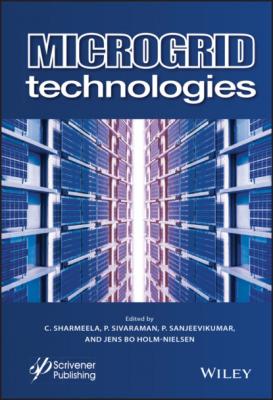Microgrid Technologies. Группа авторов
Читать онлайн.| Название | Microgrid Technologies |
|---|---|
| Автор произведения | Группа авторов |
| Жанр | Зарубежная компьютерная литература |
| Серия | |
| Издательство | Зарубежная компьютерная литература |
| Год выпуска | 0 |
| isbn | 9781119710875 |
Figure 2.5 Basic UPFC.
If the compensator connected with the energy storage capacitor, then it can absorb active power too. The transmitted power P and reactive power −jQ can be expressed by:
2.4 Generalized Unified Power Flow Controller (GUPFC)
The basic circuit of a GUPFC developed by Fardanesh in the year 2000 is shown in Figure 2.6. It inferred from the figure that it is a combination of UPFC and Interline Power Flow Controller (IPFC). There is one shunt connected converter (STATCOM) and multiple series-connected converters (SSSC). The series converters and shunt converter are connected to a common capacitor to form the DC bus. The shunt converters and the series converters act as a synchronous voltage source (SVS). These converters can generate reactive power at their terminals. Free exchange of real power is possible because of common DC link. The real power demand is fulfilled by shunt converter, which at the same time can absorb or supply controllable reactive power and exchange the same with series converters. The series converters can individually inject a voltage to the appropriately connected feeder whose magnitude and phase angle can be varied to obtain the desired voltage output. Thus the series converters act as a series compensation device. It means that the overloaded feeder lines can be balanced and any surplus power utilized by other feeders or common DC link [1, 12, 13].
Figure 2.6 Basic GUPFC.
2.4.1 Mathematical Modeling of GUPFC
The basic circuit shown in Figure 2.6 is considered here for modeling. The development is based on the fundamental frequency model of UPFC which is presented in Refs. [14] and [15]. The basic concept of UPFC has briefly explained already in this section. Modeling aims to determine the relationship between unified DC bus voltage and injected voltage. A three-phase, PWM controlled voltage source inverter is typically made of six controlled switches (GTO valves with six anti-parallel diodes) switched on and off at very high frequency around 5 kHz. The model considered a stable voltage condition for fundamental frequency voltage sources. One source is connected in parallel while the other connected in a series branch.
The series converters are injecting voltage and hence in the equivalent diagram in Figure 2.7 it is represented with voltage source and modeling is also based on this assumption [16]. The instantaneous power flowing into shunt inverter from AC bus, neglecting transformer losses and assuming balancing conditions with fundamental frequency, can be represented by:
Where,
(2.7a)
Figure 2.7 GUPFC equivalent circuit.
(2.7b)
(2.7c)
(2.7d)
This model consists of two voltage sources. These voltage sources are gained from inverters connected in series and parallel. Hence amplitude modulation factors are used to calculate voltage source magnitudes as:
(2.8)
(2.9)
Where,
k = constant based on type of inverter (for six pulse converter
The power delivered by GUPFC in steady state is given by:
Where,
(2.12a)
(2.12b)
(2.12c)
Using line impedance for calculating voltage as shown in Equation (2.6), Equation (2.11) can be rewritten as:
(2.13)
and
